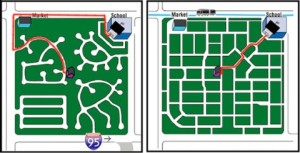When people critique cul-de-sacs, a lot of the time they’re actually critiquing the suburbs more generally. The cul-de-sac has become sort of like the mascot of the suburbs– like if suburbia had a flag, it would have a picture of a cul-de-sac on it. Cul-de-sacs by definition aren’t well connected to other streets and they are far away from town centers.
People can argue whether or not these are pros or cons, depending on what lifestyle choices they prioritize. For little kids, cul-de-sacs can be great, but they do have some real, quantifiable design flaws. Imagine being a garbage collector, or a street cleaner, instead of driving down one long street and collecting all the garbage from that street, then taking a right onto the next street and so on, you have to turn around in all of these cul-de-sacs over and over again. It takes more time and uses more gas. They’re expensive for governments to maintain, and now, governments are starting to enact regulations against them.

Producer Katie Mingle talks with Matt Lassiter about cul-de-sacs, the pitfalls of suburban design, and of course, E.T.
Special thanks to The Congress for the New Urbanism, who provided very helpful background information for this piece.

Katie Mingle works for the Third Coast International Audio Festival. She produces Re:sound, hosts the Third Coast Podcast and develops features for the TCIAF website. If you aren’t familiar with the Third Coast International Audio Festival, get familiar! It’s the best.
ALSO — Thank you, beautiful people! The show received dozens of new iTunes reviews and well over 100 new followers on Facebook. It was so lovely to read everyone’s kind words about the show and know that I’m at least partially achieving my many goals for the program. Several of the reviews could’ve been lifted directly from my mission statement (the one in my head) so clearly that you’re picking up what I’m laying down. I knew you were capable, but I wasn’t sure I was. Anyway, your reviews have been very effective and are helping the show stay high up in the “Arts” rankings. Keep them coming! Thanks, again!



Comments (6)
Share
http://www.youtube.com/watch?v=6ophEYd4A-Q
Hey Scott,
Haha that video is based on the town I live in. The map they show is an exact mirror image of Stevenage! An innovation at the time but, to be frank, it’s a run down dump now!
The plural is actually culs-de-sac.
I live on a very urban cul de sac, in Richmond, CA. I love how great it is for the kids in the neighborhood, and for impromptu conversations in the middle of the street. We all haul our trash cans out to the cross street at the entrance of the cul de sac,so that the trucks don’t have to come in (more gas, more hassle for the drivers, and for our little street, more wear and tear). The trucks don’t enter for street cleaning either – we sweep once in a while.
I think what makes it nice though is a combination of the shape of the street and the design of the housing association here – we are a cooperative where all the houses are owner-occupied, mostly low-income, very diverse.
The tree at the end of the cul de sac becomes the gathering place for picnics and birthdays – which makes it feel like some rural village plopped down in the city.
What I love about this episode is the, almost back-to-the-future, time-travelling depiction on something that hasn’t happened yet. But is slowly happening. I live in Durban, South Africa and suburban sprawl is still a fairly new problem we are facing. Because, like the US, land is plentiful which is great but also not so much. The sprawl has led to decay in all our cities, which then leads to further disinterest in the centres, which leads to further sprawl. The problem now, which is where we can relate to your broadcast is that the suburbs, residentially (if that’s a word), hold all the wealth, which attracts crime and leaves the centres and CBDs pretty quiet and alot safer, regardless of what the majority of the country thinks.
Which is interesting. The suburbs were the safe, paradise away from the hustle of the hub. And now have become super dangerous to live in. Which then leads to increased security and more ridiculous, separated gated communities, too removed from real society.
The wave of decay and rejuvenation is happening and slowly but surely, we can see interest coming back into the city centres around the country. Durban is a little slower than the rest, but has the biggest potential.
Thanks again for the cool episode, stream, download, thing, be it 3 years late. The cul-de-sac curve of modernism and sprawl is the most fascinating thing. Especially in 3rd world cities.
Peace
I was introduced to this podcast on Tuesday (via the Wild Ones episode, and have basically binged-listened to over 25 of these non-stop over this last week. Love this one. What is the song that is played at the very beginning?